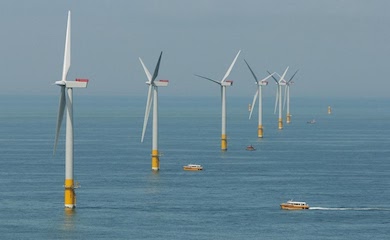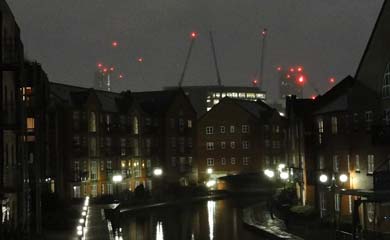Developing buildings
Building developments face a myriad of hurdles between their inception and their construction. Issues that are difficult to resolve, or those that come up unexpectedly, can cost time, money and even threaten a project from being realised.
Worse still are cases when a real problem arises after construction, such as the infamous case of London’s 20 Fenchurch Street development which melted car parts due to solar convergence[1]. However, in this article we’re taking a look at the slightly less dramatic but equally important issues with radar.
Radar problems
Radar interference can be a significant issue for building developers in countries all over the world. On the face of it, this may seem surprising since radar are designed to detect aeroplanes up in the sky and buildings are down on the ground. However, buildings can interact with emitted radar signals and have an adverse effect. In order to understand this, it is important to consider how a radar works.

Figure 1: A radar installation in the UK
Simplistically, a radar is similar to a lighthouse, but with radio waves rather than visible light waves. The rotating antenna emits a radio pulse. If this pulse reaches a target e.g. an aircraft, the target can be detected. Aircraft are easier to detect if they are closer to the radar, or if they are very large – in the same way that a boat is easier to see if it close to a lighthouse, or if it has a large sail.
Types of Radar
There are many types of radar which are used for various purposes. These include civil and military installations used for air traffic, marine traffic and monitoring weather patterns to name a few.
In the context of buildings, the most commonly affected radar types are for civil and military aviation purposes. Specifically, the two types of radar that most often require studies are:
Primary Surveillance Radar. This is a ‘non-cooperative’ surveillance system, which essentially means it will detect targets whether they like it or not. A radio pulse is emitted, and the radar will then detect any echoes. Based on the bearing of the radar when the echo is received, and the time difference between the outgoing and incoming signal, the direction and distance to the target can be calculated.
Secondary Surveillance Radar. This is a ‘cooperative’ surveillance system, which means it will only detect targets fitted with a transponder. An outgoing ‘interrogation’ signal is received by the transponder, which sends a reply signal back to the radar containing various information about the aircraft.
Both Primary and Secondary Surveillance Radar are utilised by civil and military aviation stakeholders. Buildings that are constructed near radar can affect their performance in the following ways.
Shadowing
This is relevant for Primary and Secondary Surveillance Radar. If an emitted radar signal illuminates a building, the signal strength in the shadow of the building is reduced. This can be problematic if the shadow zone extends into a volume of airspace where aircraft could be located. The issue is exacerbated if the aircraft are small such as microlights or helicopters.
The location, severity and altitude of the shadow zone is dependent on the relative position of the building and the radar. It is also relevant whether existing or planned obstructions exist between the radar and the building (which could limit the level of illumination in the first place) or beyond the building (which could limit the effective shadow because an established one will already be in place).
Shadowing concerns for Primary and Secondary Surveillance Radar are relatively common in mainland Europe. Shadowing concerns for either radar type are relatively rare in the UK.
Reflection
Buildings can present large flat façades which can reflect radar signals. In most modern systems, there is little chance of a building being detected as a target and displayed on a radar screen – because radar systems are generally equipped with a ‘moving target indicator’ which will filter out static returns. This is precisely because many radar are surrounded by terrain and buildings which air traffic controllers do not need to see marked on their displays.
However, there is potential for a radar signal to be diverted via a building façade on the way to or from a target. Recall that a radar calculates position and distance based on the direction of the returning signal and the time difference between the outgoing and incoming signals. If the path to the aircraft is diverted via a reflector (building), the target’s position and range can be incorrectly calculated and displayed.
Reflection concerns for Primary and Secondary Surveillance Radar are relatively common in mainland Europe. Reflection concerns for Secondary Surveillance Radar are common in the UK.
What to do
First and foremost, when developing a building, consider radar impacts. Often, air navigation service providers are statutory consultees for planning applications and concerns from airports are likely to carry significant weight with the relevant authority.
Where a potential radar concern is identified, it is beneficial to undertake a technical assessment. The precise form of the assessment depends on the radar type, the range and the applicable guidance for the development in question. In general terms, however, comprehensive assessments include:
- Identification of all potentially affected radar.
- Consideration of the radar type.
- Radar line of sight analysis.
- Shielding assessment – considering existing and permitted obstructions, including terrain, in the area.
- Quantification of technical impact.
- Operational significance of predicted technical impact.
- Recommended mitigation solutions, if appropriate.
Mitigation
The most appropriate mitigation option will depend on the specific scenario. Options to explore can be:
- Operational mitigation – whereby small, tolerable impacts can be incorporated by the radar operator.
- Changes to building design.
- Technical mitigation for the radar system including:
a) Software upgrades to incorporate known reflectors.
b) Physical upgrades to the radar.
c) Replacement of the radar.
Any mitigation strategy will need to be progressed in close collaboration with the radar operator.
Pager Power
Pager Power has been conducting aviation assessments for more than fifteen years. The company has developed good relationships with aviation stakeholders in many countries and assisted in overcoming aviation issues for numerous projects (see our projects page for more information). If you wish to discuss any of your existing or upcoming projects, please do not hesitate to contact the team.
References
[1]BBC (September 2013), ‘Walkie-Talkie skyscraper melts Jaguar car parts (https://www.bbc.co.uk/news/uk-england-london-23930675), BBC News



